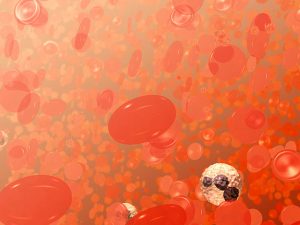2.1 Introduction to Blood

Image: Red blood cells. Source: National Cancer Institute, Donald Bliss (Illustrator), Wikimedia Commons
Chapter Objectives
After studying this chapter, you will be able to:
- Identify the primary functions of blood, its fluid and cellular components, and its physical characteristics
- Identify the most important proteins and other solutes present in blood plasma
- Describe the formation of the formed element components of blood
- Discuss the structure and function of red blood cells and hemoglobin
- Classify and characterize white blood cells
- Describe the structure of platelets and explain the process of hemostasis
- Explain the significance of AB and Rh blood groups in blood transfusions
- Discuss a variety of blood disorders
Introduction
Humans are multicellular organisms composed of a network of well-organized cells, which include various tissues and organs. These cells are often situated deep within the body and shielded from the external environment. Human blood is a connective tissue that serves as a dynamic fluid transport system, and plays a crucial role in delivering essential elements, such as oxygen and glucose, to every single cell, ensuring their proper function and vitality. Blood not only provides nourishment to cells but also removes metabolic waste products, which helps to sustain a healthy internal environment—a process referred to as homeostasis.
The heart, a muscular organ at the center of the thoracic cavity, diligently pumps oxygen-rich blood throughout the body by rhythmically contracting and relaxing. This pumping activity relies on a complex network of blood vessels, such as arteries, capillaries, and veins, that transport blood to and from the heart while facilitating the exchange of materials between the blood and tissues. A healthy body relies on these vessels to deliver nutrients and oxygen from the digestive and respiratory systems to cells, while removing waste products from them. Together, these three components—blood, heart, and vessels—make up the cardiovascular system. This chapter focuses on the fluid transport medium: blood.
Louisiana Lagniappe
Louisiana’s high rates of diabetes and obesity play a crucial role in the prevalence and severity of peripheral artery disease (PAD). PAD is a serious circulatory condition that involves the narrowing of arteries, significantly diminishing blood flow to the limbs, especially in the legs. High glucose levels (diabetes) damage the inner lining of blood vessels called the endothelium. When diabetes is poorly managed, it can cause significant damage to blood vessels and nerves throughout the body. This vascular damage increases the likelihood of developing dangerous arterial blockages. When blood glucose levels remain elevated, the body experiences an accelerated progression of atherosclerosis, a condition characterized by the hardening and narrowing of the arteries. This acceleration is a major contributor to the development of PAD, which can lead to severe health complications.
In parallel, obesity poses its own set of challenges by promoting increased inflammation and insulin resistance, both of which are harmful to vascular health. Furthermore, individuals dealing with obesity often experience elevated cholesterol levels, which leads to the buildup of arterial plaque. This combination of factors creates a perfect storm for the development of serious cardiovascular conditions, making it essential to manage both diabetes and obesity effectively to protect overall health.
